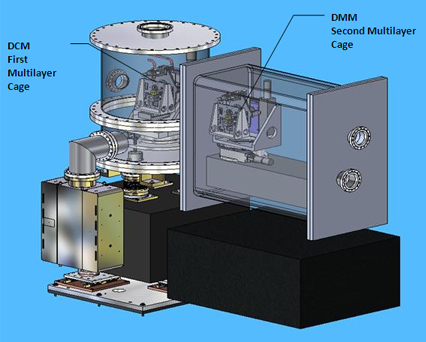Ultrafast scanning upgrade for fast tomography and high-throughput chemical imaging (MFU)
The hard x-ray micro and nanoprobes at the x-ray fluorescence microscopy beamline provide sub-micron spatial resolution across an energy range of 4–25 keV. The scanning x-ray microprobes provide high resolution elemental mapping for µ-XRF and µ-XANES for elemental and chemical microanalysis. The XFM beamline commenced user operation in early 2009 and accommodates a diverse range of environmental, biological and materials science applications and is currently one of the most over-subscribed beamlines with extremely high demand for x-ray fluorescence elemental mapping. The 384-element Maia fluorescence detector developed by BNL and CSIRO featuring a large solid-angle planar silicon array enables count rates up to 107 events/sec. A Silicon Drift-Diode upgrade to this detector expected to be realised within the next 3-5 years will enable measurement of count rates well in excess of 108 cts/sec.
Upgrades to the optics and scanning stages described in this proposal would simultaneously increase the specimen throughput at the XFM beamline – thus relieving user demand – and enhance capabilities. These enhanced capabilities are required to capitalise on the ultrafast capabilities of the current and future generations of the Maia 384 detector, which is presently unique to the Australian Synchrotron.
The in-vacuum undulator source provides an opportunity to use the natural energy width of the harmonics as monochromatic sources. In order to transmit this entire energy width, a double multilayer monochromator (DMM) would be incorporated with a bandpass of ~10-2. The estimated increase in flux is 20-50 times that obtained using an existing double crystal monochromator.

Conceptual design of the integrated DCM and DMM.
Deliverables
1.DMM including vacuum chamber, second multilayer cage, goniometer and long travel range.
2.Multilayer substrates and their coatings.
3.Fast scanning stages for fluorescence tomography on the KB mirror microprobe.
4.Additional electronics required to support fast scanning.
5.Ancillaries for intermediate energy studies would include energy dispersive detectors optimised for low energy and a helium environment sample chamber.
Outcome: Ultrafast scanning fluorescence for chemical mapping
The DMM would provide more than an order of magnitude increase in flux and coupled with fast fluorescence Maia detection scheme and fast scanning stages would increase scanning rates by 3-4 orders of magnitude. This would enable:
- mega-pixel elemental maps in an hour on dilute samples and realise
- fluorescence tomography and
- high-definition chemical mapping on practical time scales.
![]() Download Full Project Proposal Here (pdf, 20kb)
Download Full Project Proposal Here (pdf, 20kb)
Contact David Paterson
Position: Principal Scientist - XFM, Australian Synchrotron
Phone: +61 (0)3 8540 4165
Fax: +61 (0)3 8540 4200
Email: [email protected]
Further Information
- Contact Andrew Peele or Kia Wallwork at [email protected].











